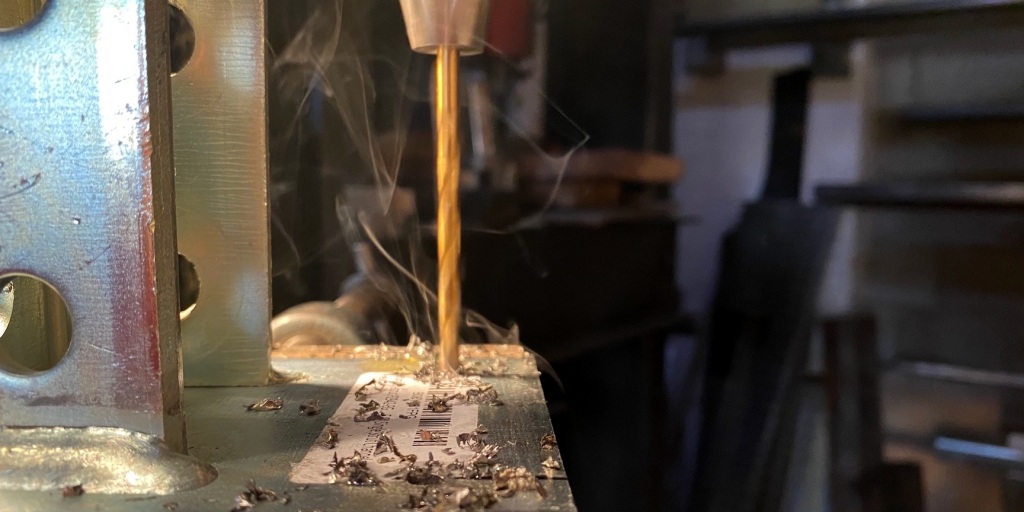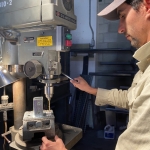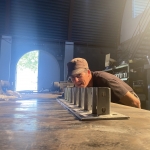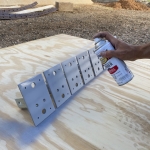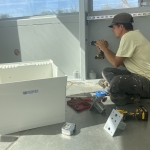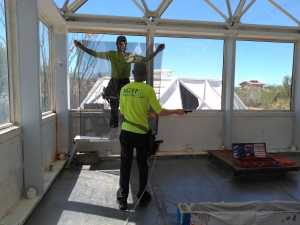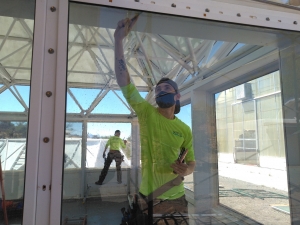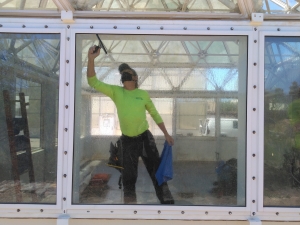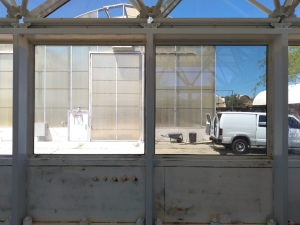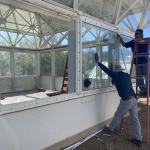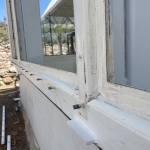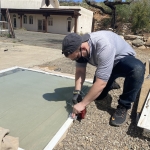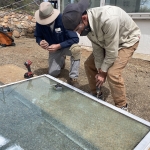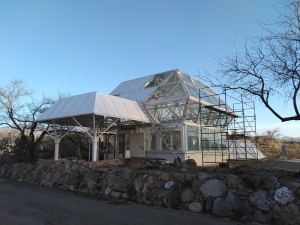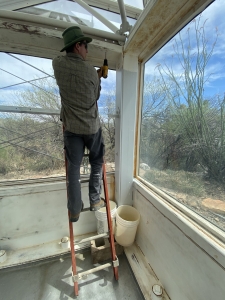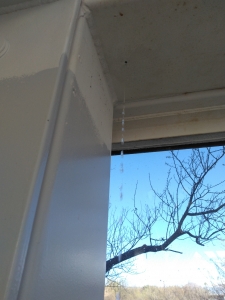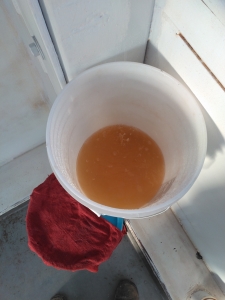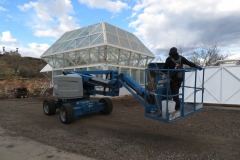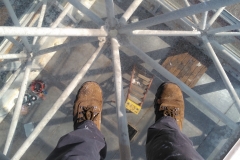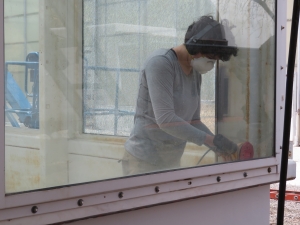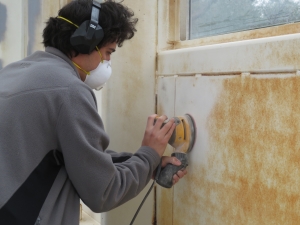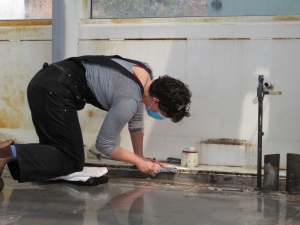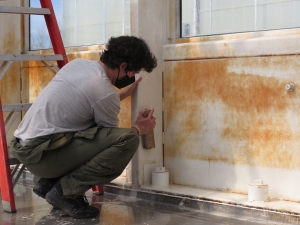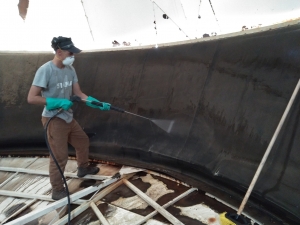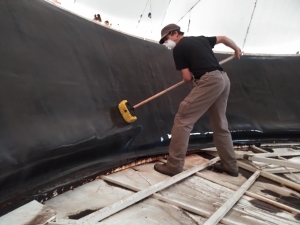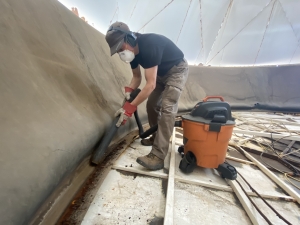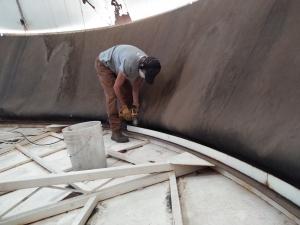SAM Construction – Data terminal removal
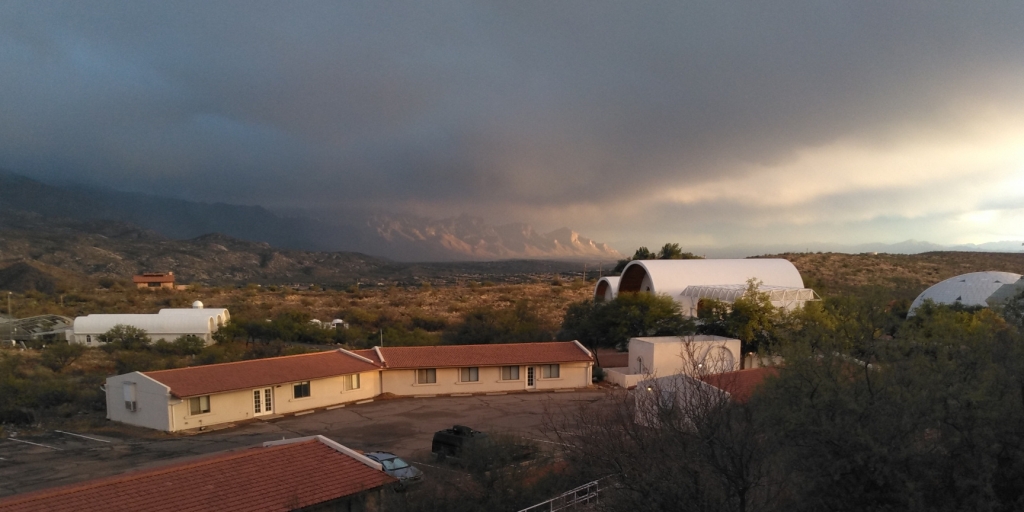
This week brought welcomed, cooler temperature, rain, and hail. The desert was alive again after a much needed storm to break the dry spell. And with that invocation of precipitation came a highly productive few days, the start of our last, long dash to the finish line in May, and first pressure tests.
Trent and Kai removed the steel frame of the original data collection terminal and kiosk. From 1987-1989 this structure served as a station for monitoring, collecting, and displaying real-time data feeds from the analog sensors in the Test Module. Data feeds were brought from within the sealed Test Module to the kiosk through flex conduit, a junction box, and PVC pipe to the kiosk, with pressure fittings and silicone rubber used to maintain air-tight fittings.
Now, with most sensors transmitting via a digital communication medium, a single USB, Ethernet, or wireless feed can route all the data generated by the Test Module. As such, the entire kiosk will be replaced by a single, simple podium where a SAM manager, visiting researcher, or tourist engaged in a presentation can view data via a laptop.
While a dozen PVC conduits were terminated, filled with expansion foam, and buried in concrete, two conduits are retained: one for electrical power, the other for Ethernet and USB. Why? A hard line provides IT support on the outside of the habitat to provide direct support and potential firmware upgrades for equipment that misbehaving. While not desired and certainly not engaged regularly, this direct support does not require a break in the seal and simulation.
At the same time, Kai and Trent were eager to remove the last of the old, long-since abandoned and very much displeasing pipes and junction box from the space between the exterior and interior doors. The steel floor was cut free, pipes cut low, and concrete poured for a new, clean, elegant entrance. Next, the walls of this small space will be sanded, primed, and painted with the installation of the new, primary electrical panel.
Thank you Tim and Terry for helping with a six bag concrete mix, pour, and finish!
SAM Construction – Catching the sunlight on Mars
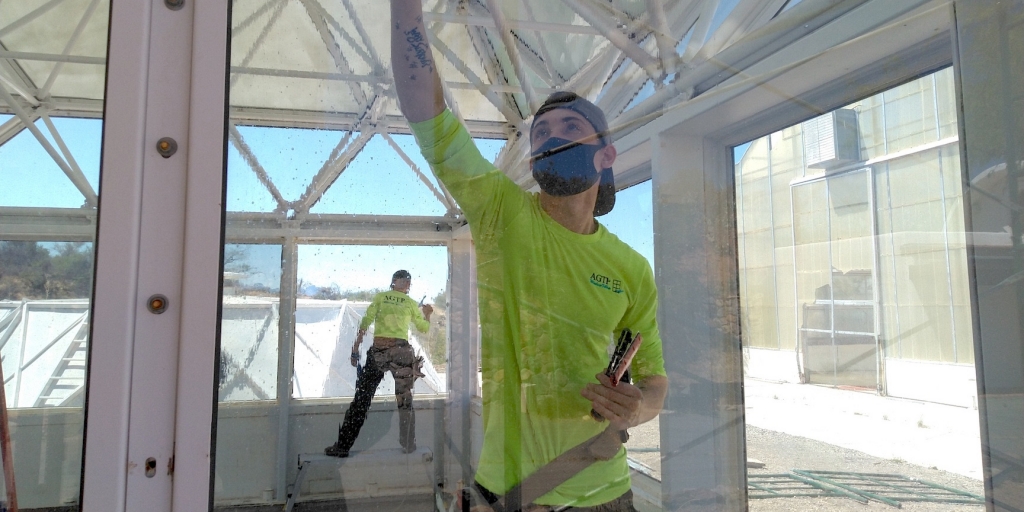
In March we selected a window tint to apply to the lower windows in order to reduce the visible light transmission to that of ambient light on Mars. Owner of Tucson based AGTP Window Films Greg Spencer (“Greg the Tinter”) and his son Tristen arrived at 9:30 am Tuesday morning and within minutes were engaged in prepping, cleaning, and applying large sheets of the window film. As with hanging dry wall, this is one of those tasks that the experts make look easy. Yet, if ever you have tried to do it yourself, you quickly learn the real challenges.
Greg and Tristen pealed, soaked, and placed thirteen sheets of window film, then used a squeegee to remove all air bubbles before the adhesive set and dried. The end result is simple beautiful. Not only did we achieve the desired, reduced ambient interior light, but these thirty year old windows now appear brand new. The film selected provides a reduction of in light with a minimal reflection such that when research team members are working inside of the SAM greenhouse at night they can yet enjoy the Moon and starlight outside.
SAM Construction – Window Swap
On the west side of the Test Module two of the four windows were cracked. Luckily, we are going to remove two when the adjacent shipping container is attached to form the workshop and corridor to the crew living quarters. In preparation for application of the window tint, we had to swap the windows such that the two good windows were relocated to the north and the two broken windows temporarily placed in the south positions.
Trent, Tim and Terry, and student volunteer Michael Blum tackled this strenuous process with expertise, using professional suction cups and a lot of muscle (each panel weighs more than 250 lbs).
SAM Construction – Scaffolding and Silicone

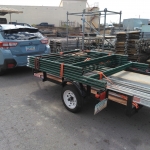 With the rather dismal failure of the cherry picker to provide an agile platform for our work on the exterior of the Test Module, we rented scaffolding instead. While a bit tricky to transport two double-stack sections on a 4×8 trailer, we managed and in fact prospered. By the end of the third day, Trent and I (Kai) could tear down and reassemble the entire rig in just under an hour!
With the rather dismal failure of the cherry picker to provide an agile platform for our work on the exterior of the Test Module, we rented scaffolding instead. While a bit tricky to transport two double-stack sections on a 4×8 trailer, we managed and in fact prospered. By the end of the third day, Trent and I (Kai) could tear down and reassemble the entire rig in just under an hour!
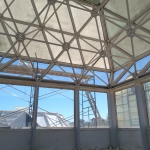 We applied two coats of a 100% silicone elastomeric to the top two rows of glass panels and the structure between. As with the top of the Test Module, this highly reflective coating helps us more closely approximate a habitat on Mars by rejecting the unwanted radiation, reducing the visible light and thermal gain, and for our terrestrial application, drastically reducing the thermal load.
We applied two coats of a 100% silicone elastomeric to the top two rows of glass panels and the structure between. As with the top of the Test Module, this highly reflective coating helps us more closely approximate a habitat on Mars by rejecting the unwanted radiation, reducing the visible light and thermal gain, and for our terrestrial application, drastically reducing the thermal load.
With each side of the TM, West, South, East, and then North we found the interior temperature reducing, the glare diminished, and quite unexpectedly, a sense of improved space. Where we feared the elegant space frame and all-glass structure might lose its futuristic style, instead it gained comfort, now more a habitat than an industrial structure.
SAM Construction – Water from Steel
Sometimes, you find water in the most peculiar places.
As we moved to paint the interior of SAM we became more acutely aware of both the location and density of the rust. Two full weeks after we last washed the interior of the Test Module, ceiling to floor, there was still rust colored water seeping from certain places. In fact, there is a fairly significant pattern—the heaviest rust was always on the left-hand side of the four corner support beams. How could that be possible?
Upon further inspection, we discovered that the mounting plates for the space frame each had four holes, but no more than two of them, often just one were filled with a bolt. The others were simple openings into the massive, horizontal steel beams. We believe that over the years the humidity condensed on the inside of the windows, rolled down onto the “V” shaped window sills, pooled and ran onto and then into the support beams by means of the mounting plate holes. There it sat, unable to further explore … until the water, oxygen, and iron worked their magic to turn much of the lower section of the Test Module to the color of Mars.
To test this theory we drilled a 1/4″ hole at the end of each beam. Sure enough, the water poured right out and into the waiting bucket. Dry at last, we are preparing to prime and paint.
SAM Construction – How to build a greenhouse on Mars
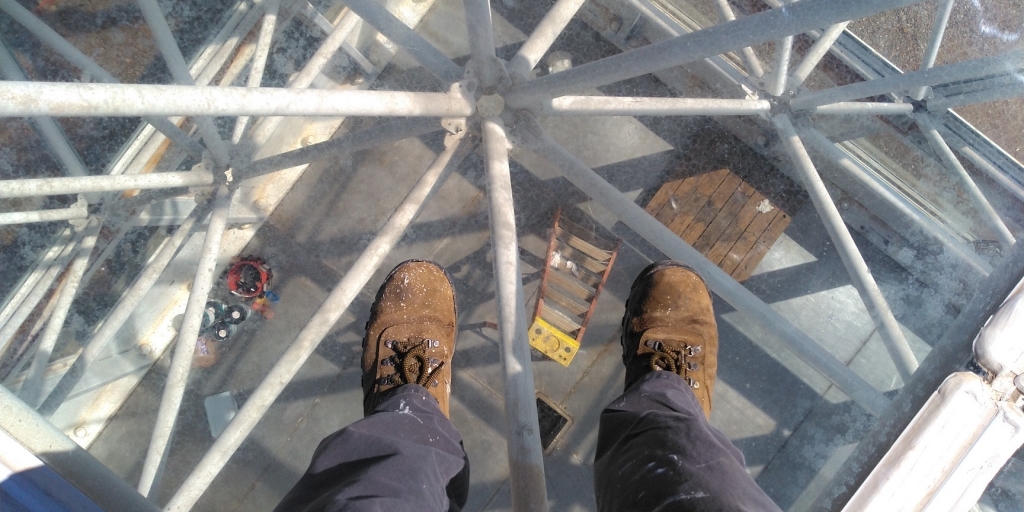
Having completed our first application of a 100% silicone elastomeric on the exterior roof panels of the Test Module lung, we felt confident in our ability to apply the same to the top of the iconic Test Module itself. It may seem odd to cover glass with a opaque, reflective coating, but our intent is clear — we intend to eliminate the direct lighting of the greenhouse of SAM to more closely approximate an exterior structure on Mars where concern for radiation would, given our current understanding and technology, keep us from long-term exposure. While most structures will likely be bermed if not buried by a few meters of regolith, this coating drastically reduces the interior light and does in fact provide a sense of being enclosed.
The cleaning of the glass was no small undertaking. Thirty odd years of dust and rain baked onto the glass does not readily wash away. We used a high pressure sprayer run from the desk of a cherry picker, then scrubbed each window pane by hand with water, TSP, and vinegar.
SAM Construction – MDRS Lends Four Hands
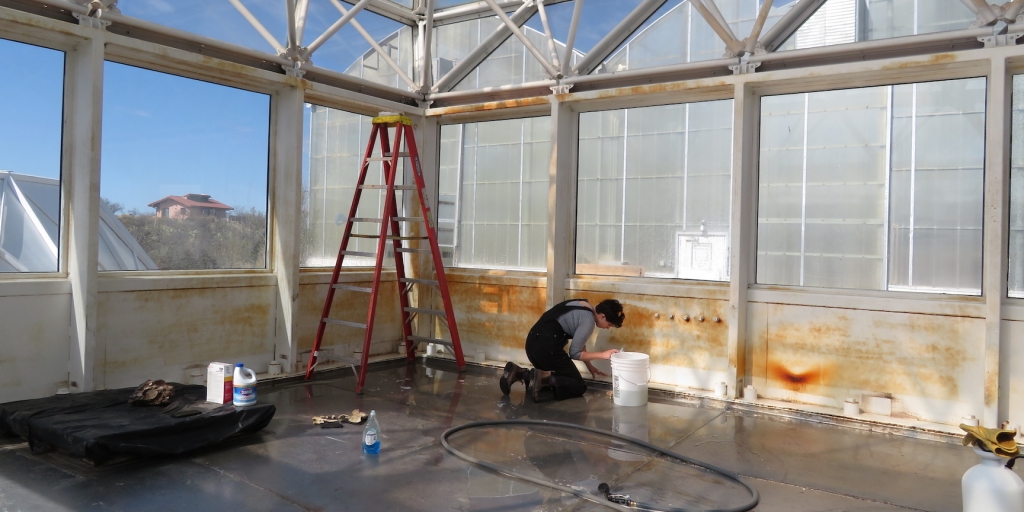
This week we have had the great pleasure of receiving two volunteers from the world renowned Mars Society Mars Desert Research Station (MDRS). Linnaea Groh and Atila Meszaros drove overland from Hanksville, Utah to spend a few days working on SAM. For four cold, wet days they removed tree roots, sanded, and painted. We thank them for a stellar close to the month of March!
Shannon Rupert, Director of MDRS was unable to visit at this time due to obligations with her own habitat analog. We look forward to having you to SAM soon! –kai
SAM Construction – Selecting window film for the Test Module
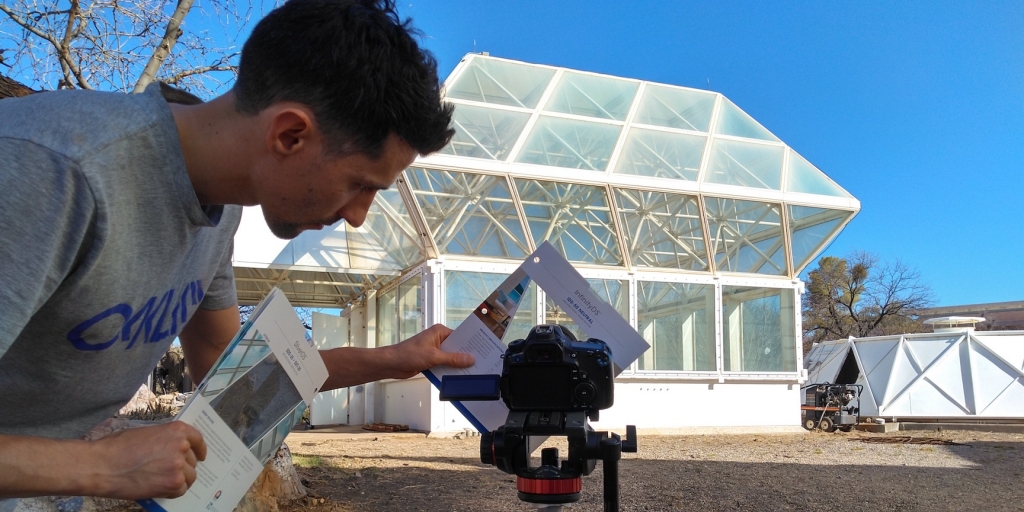
The 1987 Test Module (prototype for the Biosphere 2) will be the controlled environment / greenhouse for SAM. Many simultaneous plant studies will be conducted in the Test Module, including the growth of food cultivars to offset groceries introduced at SAM, mushrooms as a means to convert inedible biomass into digestible nutrients, and algae as a carbon dioxide (CO2) sequestration agent in addition to the variety of plants contained therein.
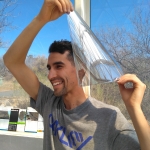 We recognize that a greenhouse such as the Test Module is not a structure that will be built on Mars, at least not in its current form. There are four reasons for this: a) radiation that the Martian atmosphere is too thin to mitigate and that glass does not reject; b) ability to manage the high pressure differential between the interior and exterior; c) ability to manage the extreme temperature differentials; and d) low ambient light for plant growth, just 590 watts per square meter on Mars compared to 1000 watts per square meter on Earth, both measured at zenith. Nearly all food cultivars will require additional, synthetic lighting even if routinely exposed to full sunlight on Mars.
We recognize that a greenhouse such as the Test Module is not a structure that will be built on Mars, at least not in its current form. There are four reasons for this: a) radiation that the Martian atmosphere is too thin to mitigate and that glass does not reject; b) ability to manage the high pressure differential between the interior and exterior; c) ability to manage the extreme temperature differentials; and d) low ambient light for plant growth, just 590 watts per square meter on Mars compared to 1000 watts per square meter on Earth, both measured at zenith. Nearly all food cultivars will require additional, synthetic lighting even if routinely exposed to full sunlight on Mars.
Therefore, we are modifying the Test Module to more closely represent a greenhouse structure on Mars, if one were to be built above ground. All surfaces facing up (the greatest exposure to radiation through the least amount of Martian atmosphere) will be painted with a reflective, white elastimeric to represent radiation shielding or regolith. The vertical glass panes (base level of the TM) will be tinted darker to reduce the ambient optical transmission by approximately 50% to match the 590/1000 watts per square meter reduction from Earth to Mars. What’s more, each film rejects between 75-85% infrared light, drastically reducing the thermal load on the total structure and thereby reducing power consumption by the mini-split air conditioners.
We used a Canon 60D camera with Tokina 12-24mm zoom lens set to a fixed ISO 250 and shutter speed 1250. We then held each of eight window films to the front of the lens and took a photo with no adjustments made. After the photo, we adjusted the f-stop ring to move the light meter back to its center, zero calibration. The difference between the two indicates the amount of light reduced, from the point of view of the camera sensor behind the film.
These are the results of our study.
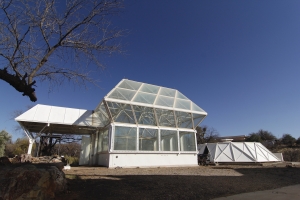
- Baseline, no window film applied
- Canon 60D, ISO 250
- Shutterspeed 1250
- Photo at f-stop 8 for a neutral lighting
- Visible Light Transmission: 100% (not including the glass itself)
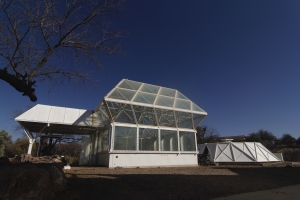
- Window film: 1DS-50 Neutral
- Canon 60D, ISO 250
- Shutterspeed 1250
- Photo at f-stop 8, adjusted to neutral at f-stop 6.5
- Visible Light Transmission: 60% with glass
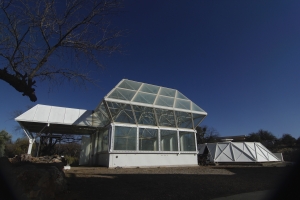
- Window film: Therm-X 50
- Canon 60D, ISO 250
- Shutterspeed 1250
- Photo at f-stop 8, adjusted to neutral at f-stop 6.5
- Visible Light Transmission: 47% with glass (see discussion below)
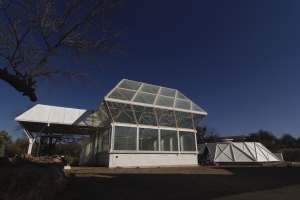
- Window film: SYDS-50 Dual Reflective
- Canon 60D, ISO 250
- Shutterspeed 1250
- Photo at f-stop 8, adjusted to neutral at f-stop 5.6
- Visible Light Transmission: 47% with glass
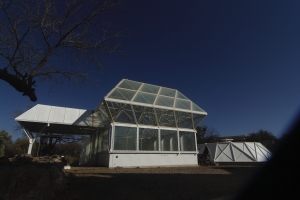
- Window film: Ceramic 45
- Canon 60D, ISO 250
- Shutterspeed 1250
- Photo at f-stop 8, adjusted to neutral at f-stop 5.6
- Visible Light Transmission: 42% with glass
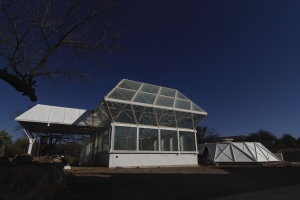
- Window film: SYDS-35 Duel Reflective
- Canon 60D, ISO 250
- Shutterspeed 1250
- Photo at f-stop 8, adjusted to neutral at f-stop 5.0
- Visible Light Transmission: 40% with glass
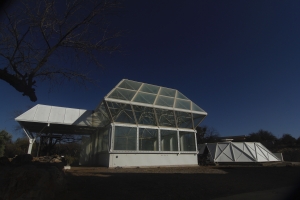
- Window film: Ceramic 35
- Canon 60D, ISO 250
- Shutterspeed 1250
- Photo at f-stop 8, adjusted to neutral at f-stop 5.0
- Visible Light Transmission: 31% with glass
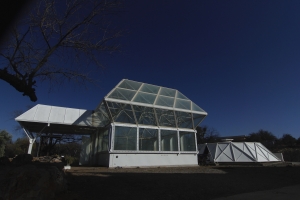
- Window film: Therm-X 30
- Canon 60D, ISO 250
- Shutterspeed 1250
- Photo at f-stop 8, adjusted to neutral at f-stop 5.0
- Visible Light Transmission: 27% with glass
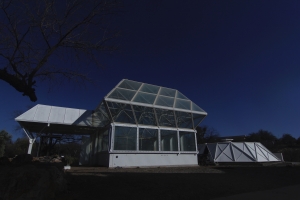
- Window film: SDS-35 / SXT-35
- Canon 60D, ISO 250
- Shutterspeed 1250
- Photo at f-stop 8, adjusted to neutral at f-stop 4.5
- Visible Light Transmission: 26% with glass
The aperture of a camera lens is measured by the f-stop value, a ratio of the focal length of the lens (entry point of light to the exit) divided by the diameter of the aperture, or the opening created by concentric sheets of thin metal that converge around the center. The larger the opening the more light that enters, thus the shorter depth of field; the smaller the opening the less light that enters, thus requiring a longer exposure and greater depth of field.
A good explanation is given by the website Expert Photography.
The full f-stop values are as follows: f/1.4, f/2, f/2.8, f/4, f/5.6, f/8, f/11, f/16, f/22, …
Where f/1.4 is the largest and f/64 is the smallest opening, each increase in value in the denominator represents a 50% reduction in light. From f/1.4 to f/2 is a 50% reduction, again from f/2 to f/2.8, and so forth. For those inclined to take the mathematics a bit further, use the formula for the area of a circle (pi * radius squared) to approximate how these values relate to the opening of the aperture.
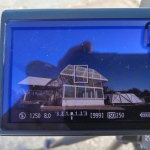 Now, we will determine which level of visible light transmission (VLT) is a good approximation to that of the average, ambient sunlight on Mars. We started with an f-stop setting of f/8. The first window film 1DS-50 Neutral invoked an f-stop of f/6.5 to bring the light meter back to 0. This is a half stop, or roughly 25% reduction in VLT. The Therm-X 50 seems to be incorrectly rated or the camera did not register properly, as its 47% VLT does not match the 75% transmission seen by the camera.
Now, we will determine which level of visible light transmission (VLT) is a good approximation to that of the average, ambient sunlight on Mars. We started with an f-stop setting of f/8. The first window film 1DS-50 Neutral invoked an f-stop of f/6.5 to bring the light meter back to 0. This is a half stop, or roughly 25% reduction in VLT. The Therm-X 50 seems to be incorrectly rated or the camera did not register properly, as its 47% VLT does not match the 75% transmission seen by the camera.
The SYDS-50 Dual Reflective and Ceramic 45 both invoke a full stop, from f/8.0 to f/5.6 which is a 50% reduction in VLT and closely matches the stated 47% and 42% VLT per the product specs. If we had a more finely graduated light meter than the one built-in to the camera, we might see values closer to the window film specs.
With the remaining window films the f-stop value moves to f/5.0 (another half stop) and f/4.5 for the darkest (two full stops from the original, unfiltered f/8.0) for a 75% reduction in light which perfectly matches the window film manufacturer specs of 26% VLT.
Furthermore, we will choose a non-reflective film such that visiting researchers to SAM will not feel boxed into the Test Module at night where interior lights would reflect back. While the windows will be darker, we do want for our analog astronauts to enjoy the Moon, planets, and stars overhead to retain a sense of the vast cosmos despite their relative isolation in the sealed SAM habitat.
It appears the Ceramic 45 window film will give us the closest approximation to the visible sunlight on Mars.
“We thank Greg Spencer, owner of AGTP Window Films from Tucson, Arizona for provision of the window film packet used in this comparative study. We discovered Greg through a local search and subsequently learned that his company was on-site at Biosphere 2 in 1991 having applied films to the Biosphere apartment windows and campus facilities. With more than 40 years experience, we are not surprised that most of those applications are yet in place and holding!
Greg has generously donated his time and materials for this unique project. We welcome the return of Greg the Tinter to Biosphere 2, and are eager for his high quality product to be installed at SAM. Thank you!” –Kai Staats, Director of SAM
SAM Construction – Test Module Lung Membrane Removed
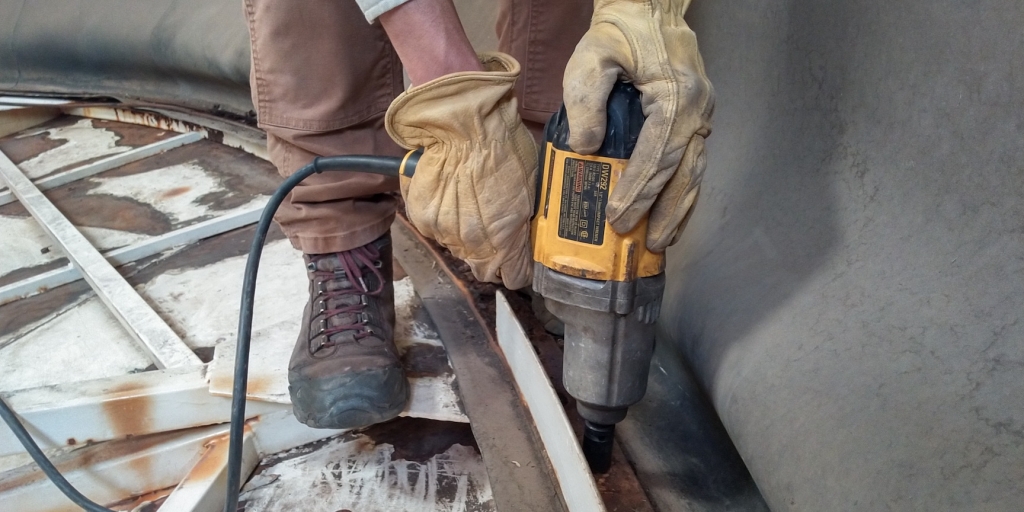
After washing and scrubbing the EPDM membrane of the Test Module lung, we attempted to remove the bolts that hold the lung membrane in place using an angle grinder, only to realize that we had dozens of hours ahead of us and an unspeakable amounts of debris from the process. Then it occurred to us that a high torque impact wrench would either remove the nuts from the welded studs or snap them off (they have to be removed anyway). We borrowed a massive DeWalt from the Biosphere 2 Energy Center and jumped right in. In less than two hours we had the metal ring sections removed and the membrane pealed free.
For the first time in thirty four years, the Test Module lung is disassembled! Now, the real effort begins as we must remove the studs and return the top flange to a pristine state before attaching all new steel studs with which the EPDM membrane will be reattached and sealed.


